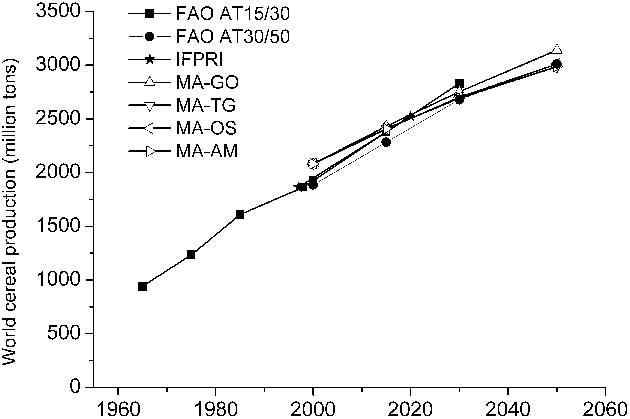relevant also from an ecological perspective. In the case of sustainable fishing, hunting and gathering, the basic structure of the ecosystem is preserved. In partial colonization, humans manage to produce crop plants and/or livestock at a density higher than that typical of natural ecosystems. Full colonization, finally, generates agroecosystems with very little in common with the natural ecosystem that they replace. Historically, there has been a trend towards intensification of agricultural systems, although in many areas extensive systems are also still common. In crop, livestock, forestry and fishery production systems, further intensification is projected to meet increasing demand worldwide. A natural consequence of the related increase in agricultural inputs (e.g., energy, fertilizers) will also be further pressure on natural ecosystems. Without intensification increasing demands would need to be met by further expansion.
Global crop production. Worldwide, numerous cropping systems can be distinguished based on agroecological parameters, cultivation and the type of crops grown. In terms of cultivation, these categories range from irrigated systems, to high external-input rain fed and low external-input rain fed systems, shifting cultivation and mixed crop and livestock systems. In time, a noticeable trend can be observed in many countries from low-input systems to high-input systems. This shift follows from an assessment of costs and benefits, weighing the costs of inputs against the increased yield levels. The shift to high-input systems had occurred in several regions of the world by the middle of the last century, but in other areas it has occurred during the last 40 years (e.g., the Green Revolution in Asia). A basic underlying driver of this shift is increasing global food demand as a result of increasing population (see 4.3.1 and 4.4.1). Low-input systems still provide a substantial share of total agriculture, in addition to providing livelihoods for hundreds of millions of resource-poor people in developing countries. For instance, shifting cultivation is the dominant form of agriculture in tropical humid and sub-humid upland regions, and low-input rain fed systems are still important in many parts of the world (FAO, 2002b). All assessments provide relatively little information on trends in underlying production systems for food crops; the discussion is more on an aggregated crop level with most attention focused on cereals. Worldwide, cereals represent about two-thirds of the total crop production and the total harvested area. In all assessments, the production of cereals is expected to increase (Figure 4-30). Interestingly, differences among the scenarios of these different assessments are very small. One underlying reason is that in all cases, the increase of global cereal production seems to be coupled to the increase in the global population. The increase in cereal production in the next few decades ranges from around 0.9% annually (lowest MA scenarios) to 1.3% (the IFPRI projection), which is slightly below the annual increase for the total crops production reported in these assessments. This number is, however, considerably lower than the increase in production over the past 30 years (around 2.1% and up to 3.1% annually in developing countries) (also the historic increase is nearly equal to the increase in population over the same period). These numbers are aggregated: for both the historic numbers and the projections there is a large varia-
tion at the regional and country scale, implying important trends in food trade and food security. Finally, it is important to note that in the time frame of the scenarios an increasing share of cereals will be used as animal feed to supply the very rapidly growing demand for livestock products.
There are two main sources of growth in crop production: (1) expansion of harvested land area and (2) yield increases. Globally over the last three decades yield increases for cereals have provided about 70-80% of production growth, while harvested land expansion contributed about 20-30% of growth. In the scenarios developed by these assessments, contribution of expansion of harvested land to increase in cereal production ranged from as low as 5 to around 30%. The lowest numbers are reported for the MA scenarios that assume high levels of technology change (Global Orchestration and Technogarden); all other scenarios find values that are near, or somewhat below the historic values. The lower contribution to total production from the expansion of crop area can be attributed to increasing land scarcity and possibly the lower overall rate of production increase. A decreasing quality of land brought into production, however, could imply that a greater percentage of gains in total production will be attributable to crop area expansion than has historically been the case (as indicated in the MA). Even in the two scenarios with little global expansion of harvested land, a considerable expansion of arable land still occurs in Africa, Latin America and partly in Asia, but this is compensated for by a decrease of harvested area in temperate zones. In the other scenarios, the largest expansion also occurs in these regions. The yield growth in these scenarios is about 0.6-0.9% annually at a global level. Several factors contribute to this (reasons are reported in more detail in the FAO and IFPRI assessment than in the MA), including increased irrigation and shifts from low-input to high-input agriculture. In any case, the assumed yield growth in each of the scenarios is considerably below the historic rate of change. The suggested trends in expansion of agricultural land in tropical zones are controversial, with questions about how this expansion can happen in many parts of the tropics (particularly in Africa) in any meaningful way.
For total agricultural land (all crops), similar trends are reported, although the area expansion is somewhat higher

Figure 4-30. Global cereal production in selected scenarios